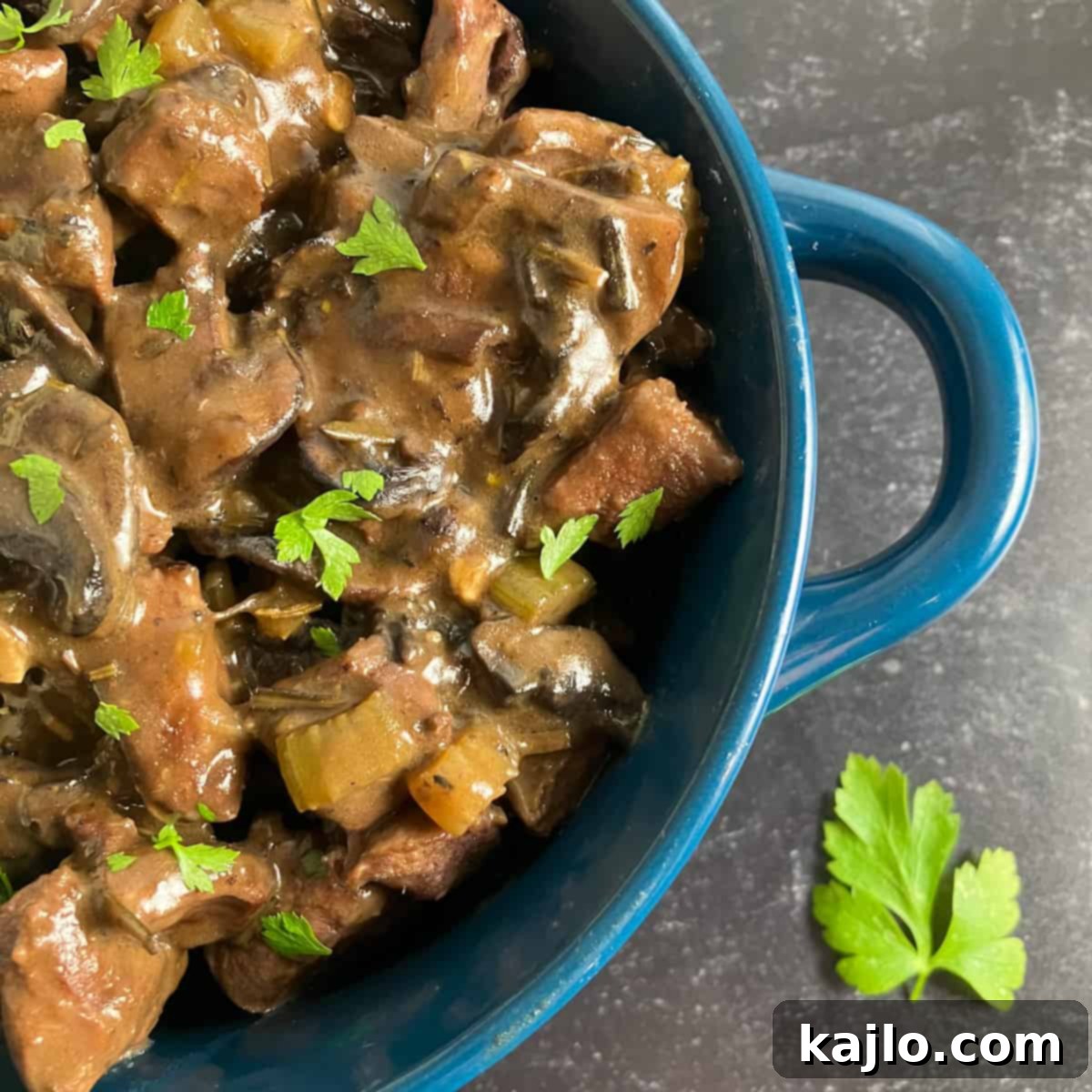Mastering Lamb Heart Stew: A Delicious & Nutritious Offal Recipe
Discover the delightful world of lamb hearts with our ultimate stew recipe! This easy-to-follow guide will walk you through preparing a tender, flavorful, and incredibly comforting lamb heart stew, perfect for any season. Far from being intimidating, lamb heart is a versatile offal that offers a mild taste, rich nutrition, and an affordable alternative to traditional meats. Learn everything from selecting the best lamb hearts and their impressive health benefits to expert cooking techniques and serving suggestions. Get ready to transform this often-overlooked ingredient into a mouth-watering meal your whole family will love!
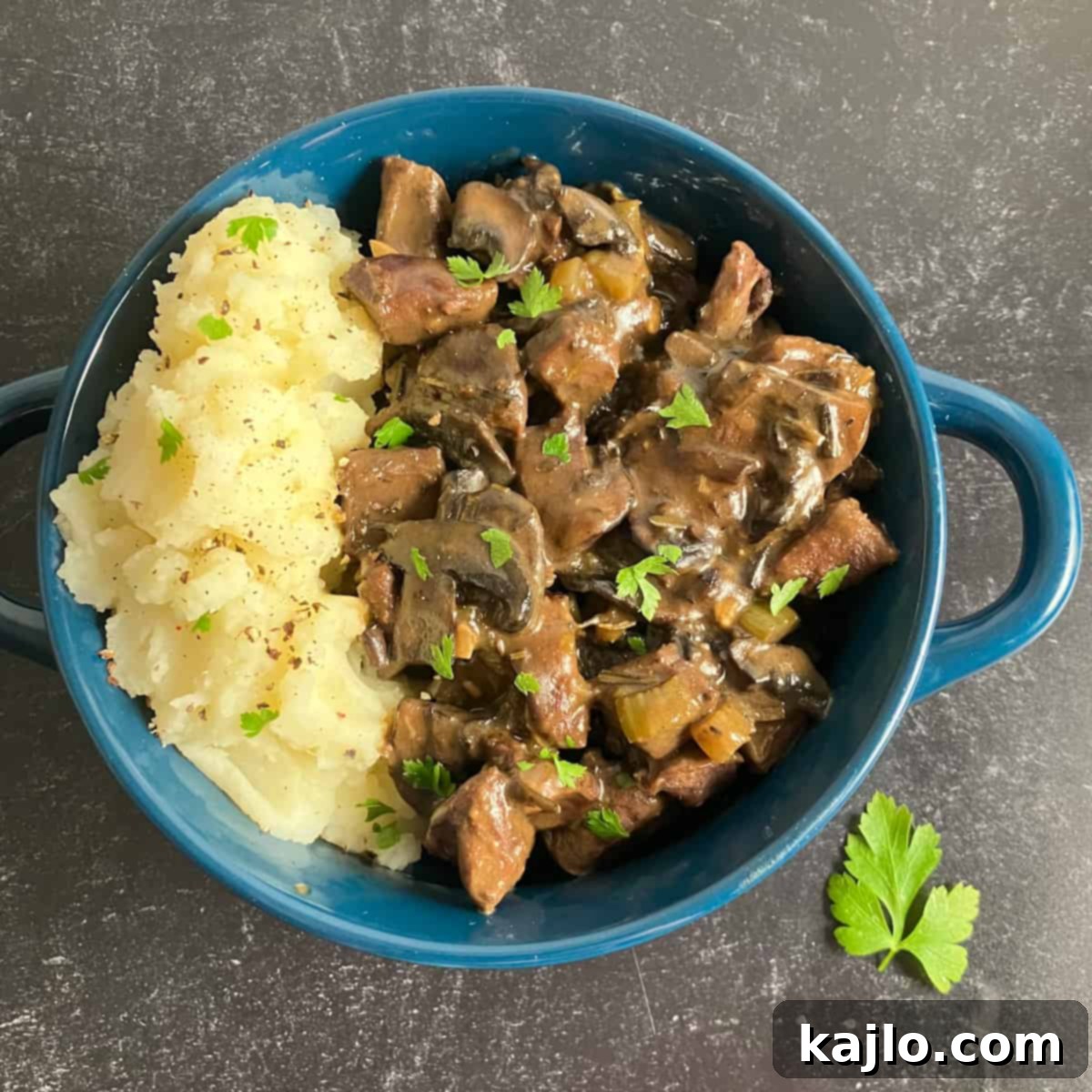
What Does Lamb Heart Taste Like? Exploring its Flavor Profile
Many people hesitate to try organ meats, often fearing a strong, gamey flavor. However, lamb heart is a pleasant surprise! Its taste is remarkably mild, often likened to beef stew meat or a tender cut of steak rather than more intensely flavored offal like liver or kidney. This makes it an excellent entry point for those new to organ meats or anyone looking for a unique yet approachable protein source.
If you enjoy a hearty beef stew, you’ll likely appreciate the subtle richness of lamb heart. Its flavor is less “lamb-y” than other cuts from the animal, which means it seamlessly substitutes beef in many stew recipes. This versatility, combined with its often lower price point (depending on your location), makes lamb heart a smart and sustainable choice. Incorporating offal like lamb heart into your diet also contributes to reducing food waste, utilizing the whole animal in a respectful and delicious way. I was genuinely astonished by how incredibly delicious this lamb heart stew turned out, and I’m confident you will be too.
Understanding Lamb Heart: Fast vs. Slow Cooking Methods
As a hardworking muscle, the heart can become tough if not cooked correctly. The secret to tender lamb heart lies in employing one of two distinct cooking philosophies: cooking it either high and fast, or low and slow. Both methods yield excellent results, but cater to different culinary preferences and preparations.
Quick & High Heat Methods: Grilling and Pan-Frying
For a swift and succulent meal, consider high-heat cooking. This approach is ideal for thinner cuts and prevents the meat from toughening. For example, grilled or pan-fried lamb heart can be incredibly tender when prepared correctly. Slice the lamb heart thinly, similar to preparing steak, and then grill or pan-fry it quickly over high heat. This method seals in the juices and creates a delightful texture. Thinly sliced lamb heart is fantastic in sandwiches, served over a fresh salad, or as quick and flavorful stir-fry pieces.
Slow & Low Heat Methods: Stewing and Braising
Alternatively, cooking lamb hearts low and slow is perfect for creating fall-apart tender dishes. This method breaks down the muscle fibers over time, resulting in a melt-in-your-mouth texture that is incredibly satisfying. Braising lamb hearts in a rich gravy or simmering them in a comforting stew, as we will do in this recipe, are prime examples of this technique. You can also braise them first and then stuff them for an impressive main course. These slow-cooking methods infuse the heart with deep flavors from aromatic vegetables and broth, making it an ideal choice for hearty, warming meals.
🔪 The Ultimate Lamb Heart Stew Recipe: Our Signature Method
For this recipe, we’re diving into the comforting world of lamb heart stew, cooked slowly on the stovetop. This method is a personal favorite because it transforms the lamb heart into incredibly tender, melt-in-your-mouth pieces, rich with savory flavor.
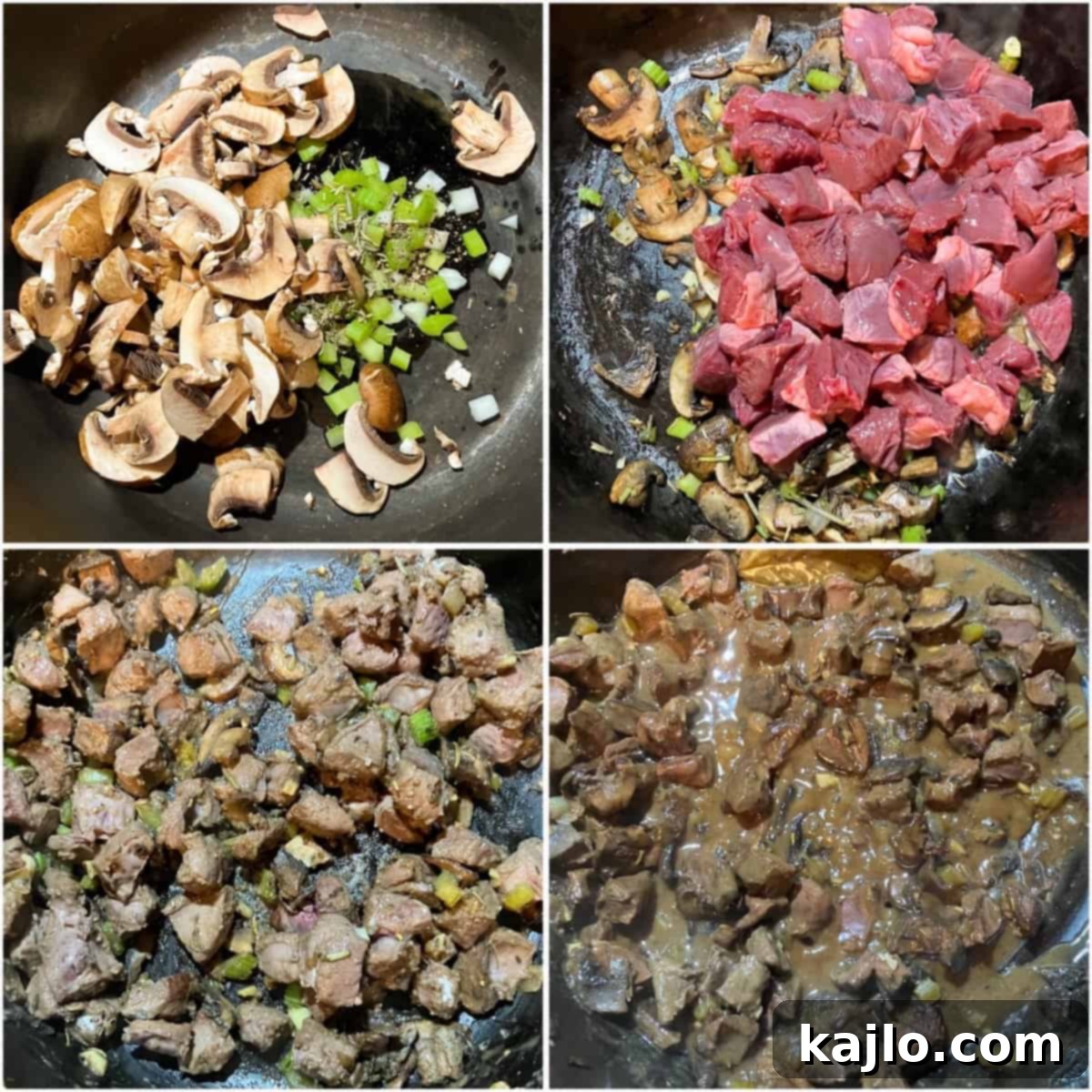
Ingredients for a Hearty Lamb Heart Stew
Gathering your ingredients is the first step to creating this delicious stew. Here’s what you’ll need to make this nourishing lamb hearts recipe:
- Fresh Lamb Hearts: Approximately 12 ounces (340 grams), or frozen lamb hearts thawed completely in the refrigerator. Quality matters, so consider sourcing from reputable suppliers.
- Olive Oil: Essential for sautéing vegetables and browning the meat. Canola oil or another preferred cooking oil can be substituted.
- Diced Celery: Adds aromatic depth and a subtle crunch.
- Diced Onion: A cornerstone of any good stew, providing sweet and savory notes.
- Sliced Mushrooms: Contributes an earthy umami flavor and meaty texture.
- Dried Thyme & Dried Rosemary: Classic herbs that complement lamb beautifully.
- Salt and Pepper: Season generously to taste throughout the cooking process.
- Minced Garlic Cloves: For an irresistible aromatic base.
- Butter: Forms part of the roux for thickening the stew.
- All-Purpose Flour: Used to create a roux, which thickens the stew to a rich, luscious consistency.
- Low-Sodium Beef Broth: The liquid base for the stew. Using low-sodium allows you to control the seasoning precisely.
- Bay Leaf: Infuses a subtle, herbal aroma into the stew.
- Frozen Diced Peas and Carrots Mixture: Adds color, sweetness, and additional nutrients.
Specific quantities are detailed in the full recipe instructions below. Remember, using a low-sodium or no-added-salt broth is highly recommended to prevent over-salting your stew.
Step-by-Step Instructions for Perfectly Cooked Lamb Heart Stew
Follow these directions to prepare your delicious lamb heart stew. The full recipe card with precise measurements is provided at the end of this article.
- Prepare the Ingredients: Start by cutting the lamb heart into 1-inch (2.54 cm) cubes. Next, dice the celery and onion into ¼-inch (0.6 cm) pieces. Finally, clean and slice your mushrooms. This uniform sizing ensures even cooking.
- Sauté Aromatics: Place a sturdy cast iron Dutch oven on your stovetop over medium heat. Add the olive oil, followed by the diced celery, onions, sliced mushrooms, dried thyme, dried rosemary, salt, and ground black pepper. Cook for approximately 10 minutes, stirring occasionally, until the vegetables begin to soften and release their fragrant aromas.
- Add Garlic: Stir in the minced garlic cloves and cook for just one more minute. Be careful not to burn the garlic, as this can make it bitter.
- Brown the Lamb Hearts: Add the cubed lamb hearts to the pot. Season with additional salt and pepper if desired. Brown the meat for about 5 minutes. This crucial step helps to seal in the juices and develop a deeper flavor profile for the stew.
- Create the Roux: Introduce the butter to the pot, allowing it to melt. Once melted, sprinkle in the all-purpose flour. Stir continuously for 1-2 minutes to cook out the raw flour taste and create a roux that will thicken the stew. Ensure all ingredients are well-coated.
- Simmer the Stew: Pour in the low-sodium beef broth and add the bay leaf. Reduce the heat to medium-low and partially cover the pot. Allow the stew to simmer gently for 1½ hours. Check on it occasionally, stirring and adding more broth if the stew appears to be getting too dry or thick. The goal is for the lamb to become fork-tender.
- Check for Tenderness: After 1½ hours, remove the lid. At this point, the lamb should be wonderfully tender. If you prefer it even softer, feel free to simmer it for an additional period.
- Finish and Serve: Approximately two minutes before you plan to serve, add the frozen diced peas and carrots mixture. Cook until heated through. Before serving, remember to remove the bay leaf. Serve hot and enjoy!
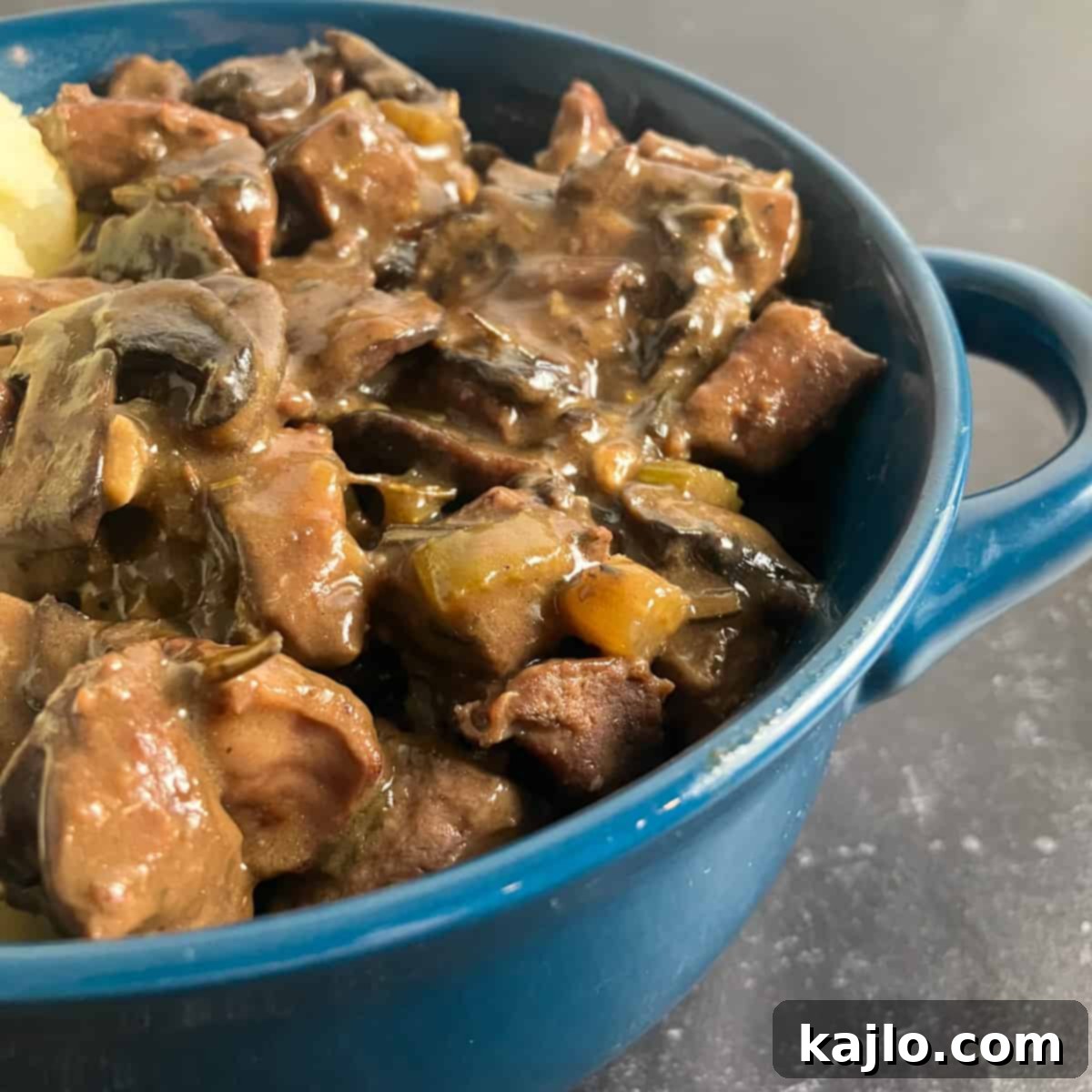
Recipe Variations: Keto & Gluten-Free Lamb Heart Stew
This lamb heart recipe is remarkably adaptable for various dietary needs. To make it a gluten-free and keto-friendly lamb heart recipe, simply omit the peas and use a low-carb, gluten-free flour alternative, such as almond flour or a gluten-free all-purpose blend, for thickening the stew.
Essential Kitchen Equipment
You won’t need a lot of specialized tools for this recipe. The primary equipment includes a good, sharp knife for preparing the ingredients and a sturdy cast iron Dutch oven for cooking the stew. The long simmering time ensures the lamb heart reaches a safe internal temperature, so a meat thermometer isn’t strictly necessary for this particular preparation.
Mutton Heart vs Lamb Heart: What’s the Difference?
Understanding the distinction between lamb and mutton is crucial for the best results in your cooking. Lamb heart comes from a young sheep, typically under one year old. This youth contributes to its renowned tenderness and milder flavor, making it the preferred choice for this stew recipe. Mutton heart, on the other hand, is sourced from an older sheep. While still flavorful, mutton heart tends to be tougher and may require a longer cooking time to achieve the desired tenderness. For the most delicate and melt-in-your-mouth stew, I highly recommend opting for lamb heart.
❓ Preparing Lamb Hearts: Trimming and Cleaning Tips
Preparing lamb hearts for cooking is simpler than you might imagine. For a stew like this, minimal trimming is required. You’ll want to remove any visible excess creamy white fat from the exterior of the lamb hearts. While some fat can be left to contribute moisture and fat-soluble vitamins, trimming it slightly can result in a leaner stew if preferred. After trimming, simply chop the hearts into bite-sized pieces, as described in the recipe instructions.
Contrary to popular belief for some organ meats, there’s no need for elaborate trimming or rinsing before cooking lamb hearts. Just a quick trim of excessive fat and a chop into pieces, and they’re ready to be added to your pot. This straightforward preparation makes lamb heart an accessible ingredient for even novice cooks.
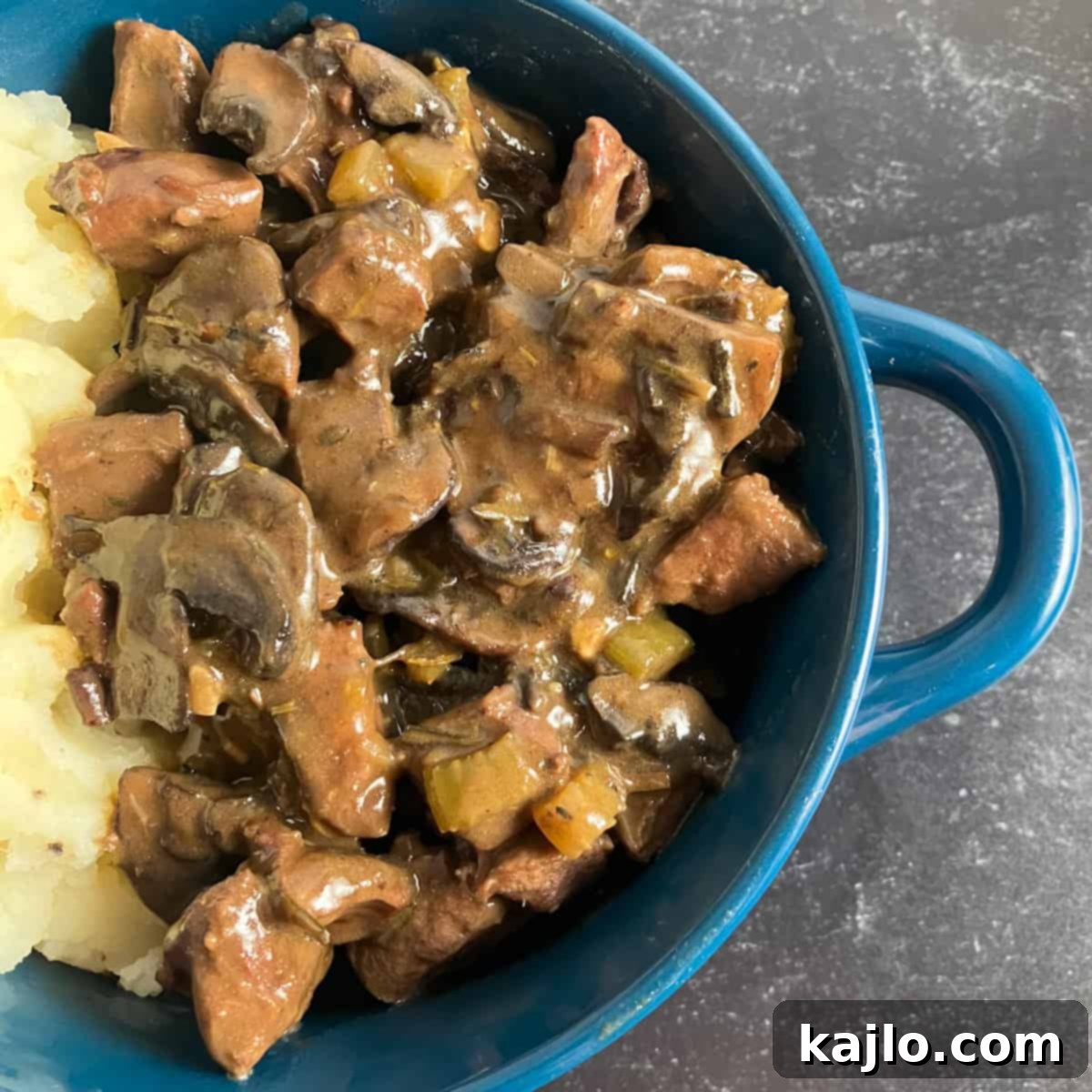
💕 Sourcing Lamb Hearts: Where to Buy Quality Offal
Finding lamb hearts can sometimes be a bit of a treasure hunt, especially in conventional grocery stores in the United States. While they might not always be on prominent display, there are several reliable avenues for purchasing this nutritious offal:
- Local Farmer’s Markets: Often the best place to find fresh, high-quality organ meats directly from producers who practice whole-animal butchery. Engaging with local farmers also allows you to learn more about their farming practices.
- Direct from Local Farmers: Many farms offer direct sales, either through farm stands, community-supported agriculture (CSA) programs, or online ordering for pickup or delivery.
- Online Retailers: Companies specializing in grass-fed and grass-finished meats frequently offer a wider selection of offal, including lamb hearts. For instance, US Wellness Meats is a popular option for sourcing quality lamb hearts online.
- Specialty Butchers: Independent or ethnic butcher shops are more likely to carry organ meats. It’s always worth calling ahead to inquire about availability or to place a special order.
Each lamb heart typically weighs around 6.5 ounces (184g), so you’ll generally need two for this stew recipe to meet the required weight. While mainstream supermarkets like Whole Foods might not consistently stock them, you may find better luck in the UK or Australia, where lamb hearts appear to be a more common food item in stores like Waitrose, Tesco, Coles, or Woolworths.

⭐ Nutritional Powerhouse: The Health Benefits of Lamb Hearts
Beyond its delicious taste and economical price, lamb heart boasts an impressive nutritional profile. Often referred to as “nature’s multi-vitamin,” offal like lamb heart is packed with essential vitamins and minerals that are vital for overall health. Here’s a snapshot of the nutrition facts for lamb hearts (per Cronometer for 4 ounces/113 grams):
- Calories: 138
- Carbohydrates: 0 grams
- Fiber: 0 grams
- Fat: 6 grams
- Saturated Fat: 3 grams
- Cholesterol: 153 mg
- Protein: 19 grams
- Thiamin (Vitamin B1): 28% Daily Value (DV)
- Riboflavin (Vitamin B2): 66% DV
- Niacin (Vitamin B3): 35% DV
- Pantothenic Acid (Vitamin B5): 30% DV
- Vitamin B6: 22% DV
- Vitamin B12: 194% DV
- Folate (Vitamin B9): 1% DV
- Vitamin A: 0% DV
- Vitamin C: 9.5% DV
- Calcium: 1% DV
- Iron: 29% DV
- Magnesium: 5% DV
- Phosphorus: 20% DV
- Potassium: 10% DV
- Selenium: 52% DV
- Zinc: 14% DV
As you can see, lamb hearts are an exceptional source of B-complex vitamins, including thiamin, riboflavin, niacin, pantothenic acid (B5), vitamin B6, and particularly vitamin B12. These B vitamins play crucial roles in energy metabolism, nervous system function, and red blood cell formation. While grains also contain B vitamins, organ meats offer them in a much more nutrient-dense and often more bioavailable form, especially compared to heavily fortified grains.
Furthermore, lamb hearts provide an excellent supply of several vital minerals, such as highly bioavailable iron (essential for oxygen transport), phosphorus (important for bone health and energy), and selenium (a powerful antioxidant). If you’re mindful of saturated fat intake, remember that visible fat can be easily trimmed from the hearts before cooking, allowing you to tailor this healthy protein source to your dietary preferences.
Is Lamb Healthier Than Beef? A Nutritional Comparison
Both lamb and beef are highly nutritious red meats that can be integral parts of a balanced diet. Each offers a wealth of B vitamins, high-quality protein, and readily absorbed forms of iron and zinc. When comparing the two, it’s not necessarily about one being definitively “healthier” than the other, but rather about incorporating a variety of nourishing foods into your diet. Both contribute unique flavor profiles and micronutrient benefits, making them excellent choices for varied and wholesome meals.
🤔 Frequently Asked Questions (FAQs) About Cooking Lamb Hearts
Can You Eat Lamb Heart Medium-Rare?
According to the USDA, lamb (including lamb heart) should be cooked to a minimum safe internal temperature of 145°F (63°C), followed by a 3-minute rest time. Medium-rare typically falls within the 130-140°F (54-60°C) range, meaning it’s technically below the recommended safe temperature. While some experienced cooks might choose to serve other tender cuts of lamb and beef medium-rare, it’s generally advised to adhere to food safety guidelines, especially with organ meats. For safety, I strongly recommend against eating lamb heart raw. When cooking quickly over high heat, a meat thermometer can help ensure the heart reaches the minimum safe internal temperature.
Can You Boil Lamb Hearts?
Absolutely! Lamb hearts are wonderfully versatile and can be used in any way you’d typically prepare stew meat. Boiling them is a perfectly acceptable method, especially as a precursor to other preparations or when incorporating them into soups and stews. They will absorb the flavors of the broth and become tender with prolonged cooking, making them a delicious addition to various liquid-based dishes.
Freezing and Storing Lamb Heart Stew
Lamb hearts, both raw and cooked, freeze exceptionally well. For long-term freezer storage, it’s best to keep them in a vacuum-sealed freezer bag to prevent freezer burn and maintain quality. This lamb heart stew recipe is also excellent for meal prep; store leftovers in an airtight container in the refrigerator for up to 3-4 days. For longer storage, the stew freezes beautifully. To reheat, simply place a serving in a microwave-safe bowl and microwave on high for 1-2 minutes, adding a splash of extra broth if the stew seems too dry.
How to Cook Lamb Hearts in a Slow Cooker
This stew recipe is perfectly suited for a slow cooker, making it an ideal option for busy days. After preparing the ingredients as described in the stovetop method (sautéing vegetables and browning the meat), transfer everything to your crock pot. If you want to avoid the stovetop entirely, you can use the sauté function of an Instant Pot to complete the initial steps. Cook the lamb heart stew on high for 4-6 hours, or on low for 6-8 hours, until the lamb is exquisitely tender and flavorful. This hands-off approach ensures a delicious meal with minimal effort.
How to Cook Lamb Heart in the Oven
Cooking lamb heart in the oven is another fantastic slow-cooking method that yields incredibly tender results. For an oven-braised lamb heart, begin by browning the lamb hearts and briefly braising them on the stovetop, similar to the initial steps of our stew recipe. Then, transfer them to an oven-safe pot or Dutch oven, cover, and bake in a low oven (around 300°F/150°C) for approximately 2 hours. This gentle, consistent heat will slowly tenderize the heart, allowing it to soak up all the delicious flavors of your braising liquid. The result will be wonderfully succulent and flavorful.
How to Pan Fry Lamb Hearts
For a quicker preparation, pan-frying lamb hearts is an excellent choice, much like cooking beef steak. Start by thinly slicing the lamb hearts into strips or small medallions. Season them generously with your preferred herbs and spices. Heat a small amount of oil (such as olive oil) in a cast iron pan over medium-high heat. Add the lamb heart pieces in a single layer, ensuring not to overcrowd the pan. Cook for 3-5 minutes per side, being careful not to overcook them, as this can lead to toughness. Pan-fried lamb heart strips are delicious served immediately as a main course or added to salads and wraps.
Is Lamb Heart Healthy?
Whether a food is considered “healthy” often depends on individual dietary needs, preferences, and overall eating patterns. However, generally speaking, lamb heart is indeed a highly nutrient-dense food. It serves as an excellent source of lean protein and is rich in a broad spectrum of essential vitamins and minerals, as highlighted in the nutrition section above. Its relatively low-calorie count per serving, coupled with its robust micronutrient profile, makes it a valuable addition to a balanced diet, potentially supporting weight management and overall wellness.
Is Lamb’s Heart Kosher?
According to Jewish dietary laws, lamb and sheep are considered kosher animals, provided they are slaughtered by a shochet (a ritual slaughterer), deveined, and salted correctly. However, preparing organ meats like lamb heart to meet all kosher requirements can be quite intricate and challenging. Consequently, it may be difficult to find lamb hearts specifically certified as kosher in many markets.
🥗 What to Serve with Lamb Heart Stew
This hearty lamb heart stew pairs beautifully with a variety of side dishes, offering both comfort and balanced nutrition. My personal favorite accompaniment is creamy mashed potatoes, which soak up the rich gravy wonderfully. Here are some other excellent options:
- Cauliflower Rice or White Rice: For a low-carb alternative or a classic, absorbent base.
- Cooked Noodles: Egg noodles or pasta can add substance and comfort.
- Air Fryer Spaghetti Squash: A light, vegetable-based “noodle” option.
- Vegan Spinach Salad: A refreshing contrast to the richness of the stew.
- Crusty Bread: Perfect for dipping into the flavorful broth.
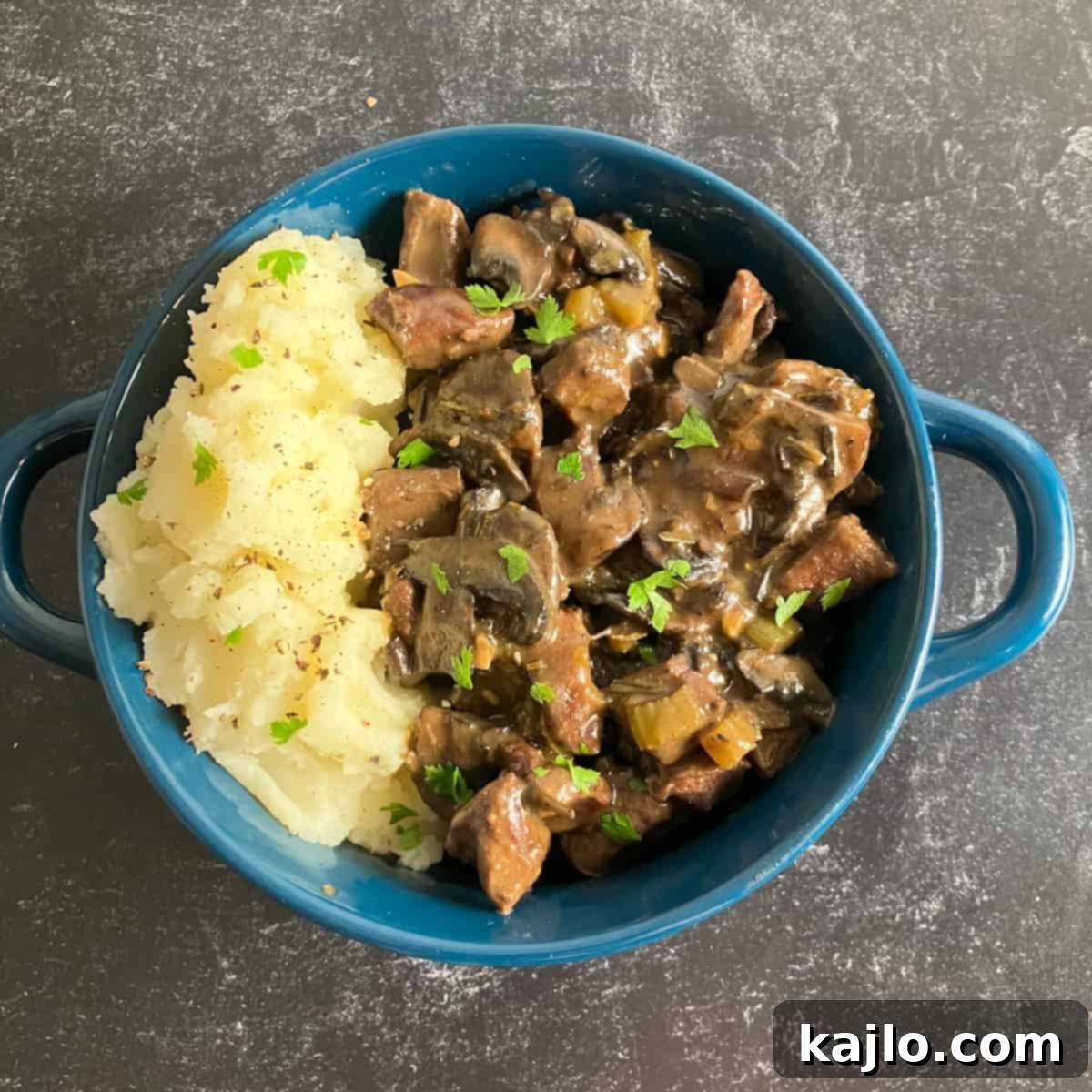
📋 Lamb Heart Stew Calories & Nutritional Summary
Understanding the nutritional value of your meal is always helpful. Raw lamb hearts contain approximately 138 calories per 4 ounces (113 grams). For this specific lamb heart stew recipe, each serving provides roughly 311 calories, 10 grams of net carbohydrates, and a robust 31.9 grams of protein. This makes it a satisfying and nutrient-dense meal.
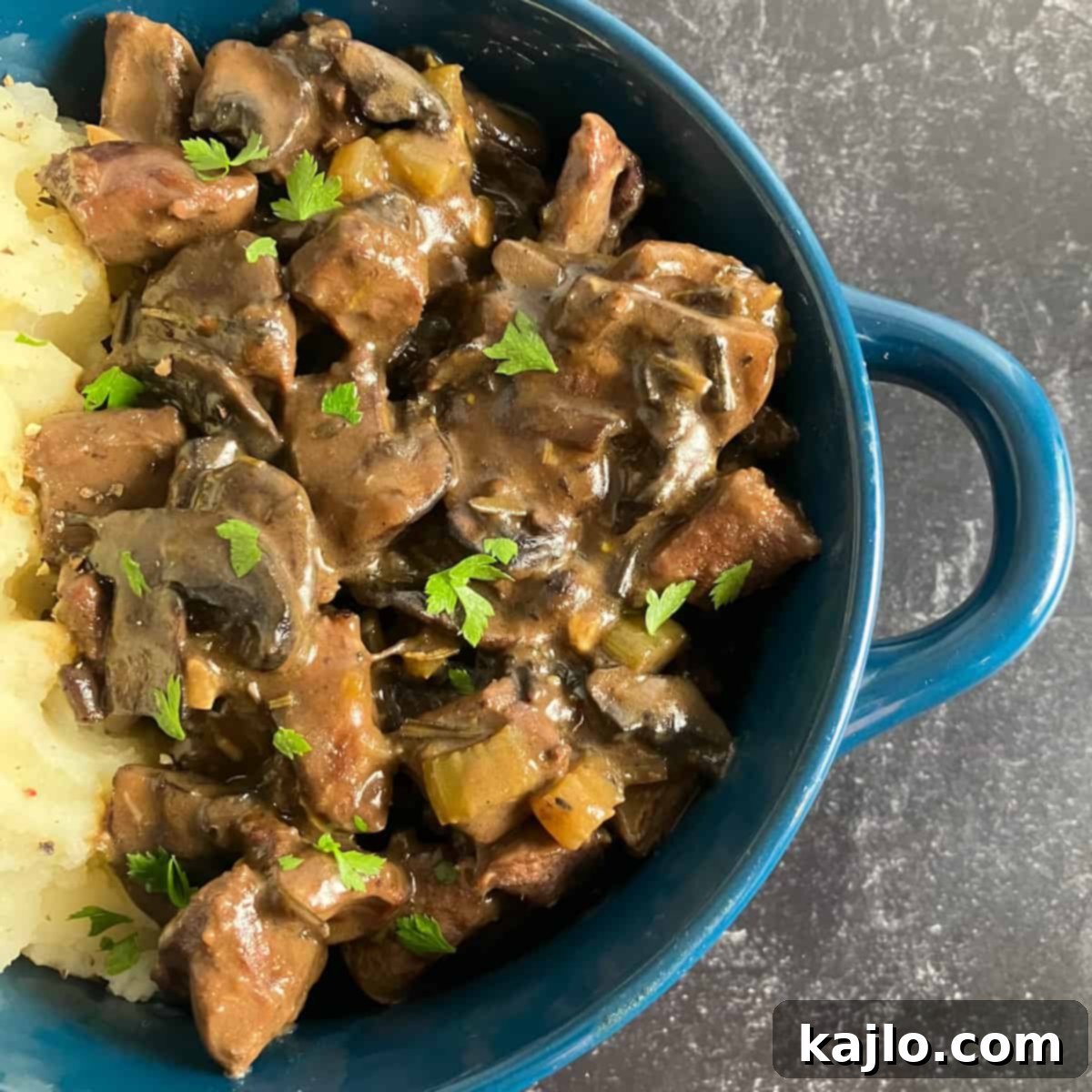
👩🏻🍳 Explore More Offal Recipes & Other Favorites
If you enjoyed this venture into cooking lamb hearts, you might be interested in exploring other delicious organ meat recipes:
- Chicken Hearts
- Cod Liver Pate
- Stuffed Bell Peppers (Air fryer or oven)
- Keto Beef Jerky
You may also enjoy this recipe for Air Fryer Lamb Shoulder Chops if you’re looking for other lamb preparations.
Lamb Heart Stew Recipe Card
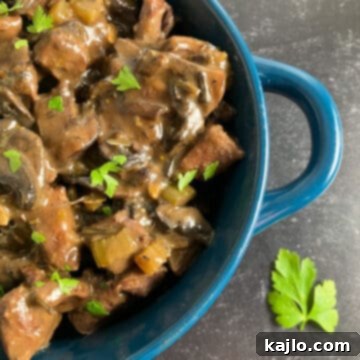
Lamb Heart Recipe (How to Cook Lambs Hearts for Stew)
A delicious and comforting lamb heart stew recipe that is easy to make and packed with flavor and nutrition. Perfect for fall comfort food!
Cook Time: 1 hour 45 minutes
Total Time: 1 hour 45 minutes
Course: Dinner
Cuisine: American
Servings: 3
Calories: 311 kcal
Ingredients
- 12 ounces (340 grams) lamb hearts
- 1 rib celery
- 1 tablespoon onion
- 4 ounces (113 grams) mushrooms
- 1 teaspoon olive oil
- ½ teaspoon dried thyme
- ½ teaspoon dried rosemary
- Salt and pepper, to taste
- 2 cloves garlic, minced
- 1 tablespoon butter
- 1½ tablespoons all-purpose flour
- 2 cups low-sodium beef broth (plus more as needed)
- 1 bay leaf
- ¾ cup frozen diced peas and carrots
Instructions
- Cut the lamb heart into 1-inch (2.54 cm) cubes. Dice celery and onion into ¼-inch (0.6 cm) pieces. Clean and slice the mushrooms.
- Put a cast iron Dutch oven on the stovetop over medium heat. Add olive oil, celery, onions, mushrooms, dried thyme, dried rosemary, salt, and ground black pepper. Cook for 10 minutes, stirring occasionally to soften the veggies.
- Add minced garlic cloves to the pot and heat for one minute more.
- Stir in the lamb hearts and add more salt and pepper if desired. Brown the meat for about 5 minutes to help seal in the juices.
- Add butter and flour (the roux), allowing the butter to melt and the mixture to coat the ingredients.
- Add low-sodium beef broth and a bay leaf. Turn the heat down to medium-low and partially cover the pot. Allow the stew to simmer for 1½ hours. Check on it occasionally and turn the heat down more if it’s getting too dry. You can add more broth if needed as well.
- Remove the lid. The lamb should be tender at this point, but you’re welcome to simmer even longer if desired for maximum tenderness.
- Two minutes before it’s finished cooking, add diced frozen peas and carrots. Remove the bay leaf and serve immediately.
Equipment
- Knife
- Cast Iron Dutch Oven
Notes from Dietitian Summer Yule
- This recipe is considered a level 1 recipe, which may support fat loss due to its high protein and relatively low-calorie content. Lamb hearts are an excellent choice for a weight management goal.
- Lamb hearts are also safe and nutritious for dogs, should you wish to share a small, plain portion with your canine companion.
- While lamb hearts contain cholesterol, they are generally not considered a “lean” protein due to this. However, visible fat can easily be trimmed to achieve a leaner, lower-fat option.
- The high protein content of lamb hearts makes this stew very filling and satisfying, helping to prevent overeating. Combining it with vegetables adds fiber and fluid, enhancing satiety, which is beneficial for weight loss.
- At around 300 calories per serving, this stew might not be enough for everyone, especially active adults or growing children. Consider serving it with a grain like mashed potatoes, noodles, or a slice of bread to make it a more complete meal, potentially keeping the total meal under 500 calories. For higher energy needs, you can easily double the grain portion. For a lower-carb option, pair it with non-starchy vegetables instead of grains.
- This stew is easy to modify for various family members’ needs. Based on one of my favorite stew recipes, it’s so good that it could easily pass for beef stew if you didn’t know it contained lamb!
- Nutrition information provided is for one serving and is an estimate.
Nutrition Info Disclaimer
All recipes on this website may or may not be appropriate for you, depending on your medical needs and personal preferences. Consult with a registered dietitian or your physician if you need help determining the dietary pattern that may be best for you.
The nutrition information is an estimate provided as a courtesy. It will differ depending on the specific brands and ingredients that you use. Calorie information on food labels may be inaccurate, so please don’t sweat the numbers too much.
“To taste” means to your preferences, which may have to be visual to follow food safety rules. Please don’t eat undercooked food.
Nutrition Information (Per Serving)
Calories: 311 kcal
Carbohydrates: 12.1g
Protein: 31.9g
Fat: 14.3g
Saturated Fat: 6.2g
Potassium: 522.8mg
Fiber: 2.1g
Vitamin A: 7.1% DV
Vitamin C: 15.7% DV
Calcium: 3.6% DV
Iron: 39.4% DV
Keywords: lamb heart, lamb heart stew, lamb hearts, lamb hearts recipe, lamb hearts stew, lambs heart, lambs heart recipe, lambs hearts
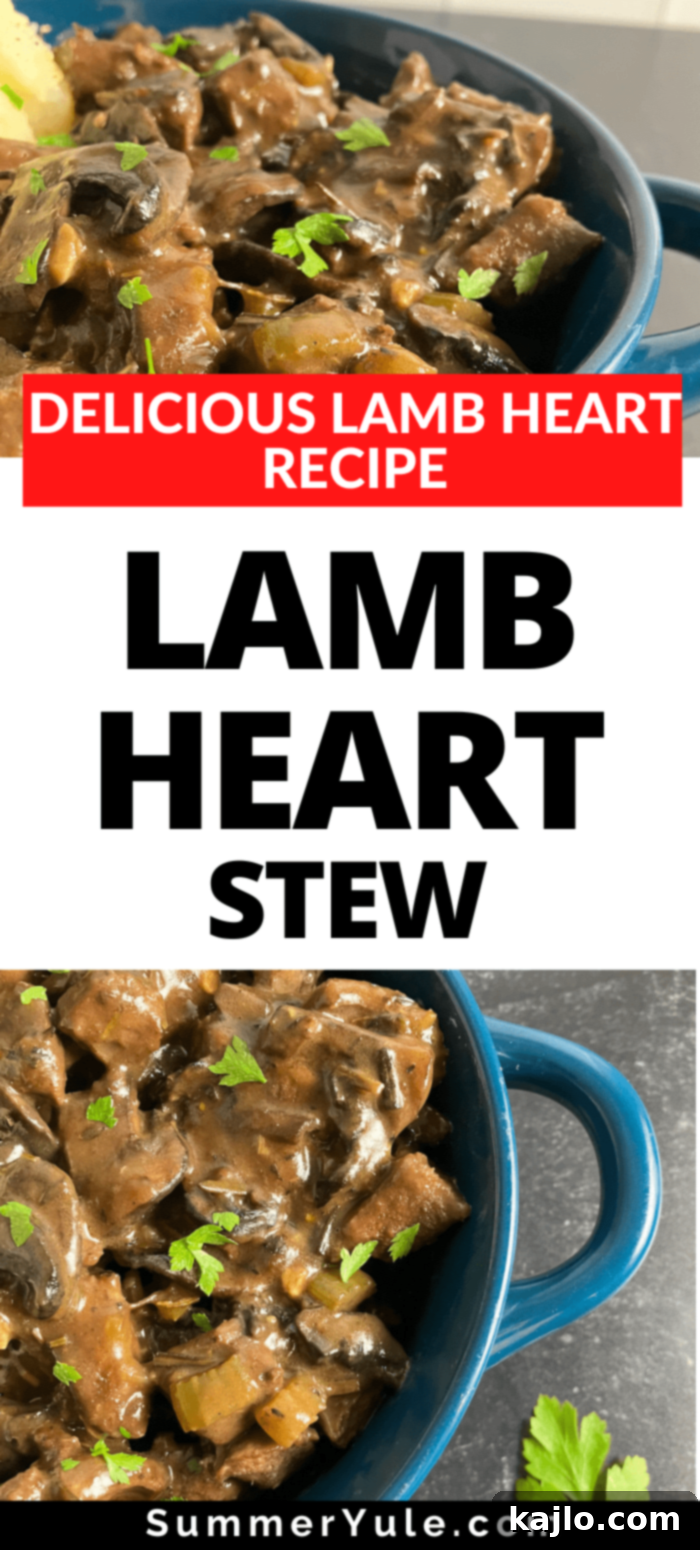
Join our community! Subscribe for all of the latest and greatest recipes, and follow me on Facebook, Pinterest, Instagram, and YouTube!
